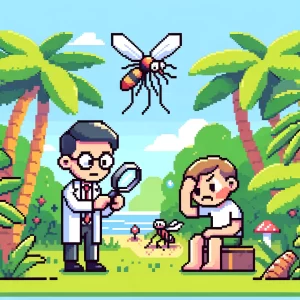
The Bed Bug Battle
Bed bugs.
Just hearing the name can make your skin crawl. It’s the fear of every business traveler.
These tiny, blood-sucking insects have made a dramatic comeback worldwide over the past two decades. But why are they back? And why should we care? This post looks at research into the fascinating world of bed bugs, their history, the reasons behind their resurgence, and the ongoing efforts to control them.
The Unwanted House Guests: Bed Bug Basics
Bed bugs, scientifically known as Cimex lectularius (common bed bug) and Cimex hemipterus (tropical bed bug), are small, flat insects that feed on the blood of humans and animals. These pests are found in homes, hotels, hospitals, and even public transportation. While bed bugs do not transmit diseases, their bites can cause itchy, red welts and lead to sleepless nights.
The resurgence of bed bugs is not just a minor inconvenience. It’s a global problem impacting millions of people. Understanding why these pests are making a comeback is the first step in winning the battle against them.
A History Lesson: From Ancient Egypt to Modern Times
Bed bugs have been biting humans for thousands of years. The earliest records of bed bugs date back to an Egyptian archaeological site over 3,500 years ago. They spread throughout the Roman Empire and continued to plague humans through the centuries. By the early 20th century, bed bugs were everywhere, from the slums to the grandest homes.
The introduction of synthetic insecticides like DDT in the 1940s nearly eradicated bed bugs in many parts of the world. For a few decades, these pests were almost forgotten. However, the ban on DDT due to its environmental impact, coupled with the development of insecticide resistance, has led to a bed bug resurgence since the late 1990s.
The Modern Bed Bug Resurgence: What Happened?
Several factors contribute to the modern resurgence of bed bugs. One major reason is insecticide resistance. Over time, bed bugs have developed resistance to many common insecticides, making chemical treatments less effective. This resistance means that even powerful insecticides may not kill them.
Global travel is another significant factor. Bed bugs are excellent hitchhikers, and they are easily traveled in luggage, clothing, and furniture. As people travel more frequently and further distances, bed bugs spread more easily across cities and countries.
Poor pest management practices also play a role. Ineffective treatments and lack of proper pest control measures allow bed bug populations to thrive. Additionally, social stigma often leads to infestations going unreported, especially in disadvantaged communities.
The Cost of Infestation: More Than Just an Itchy Bite
Bed bug infestations are not just annoying; they are expensive and can have severe economic and social impacts. Treating an infestation can cost hundreds or even thousands of dollars. For businesses like hotels, a single infestation can lead to bad reviews, customer loss, and significant financial losses. As we’ve seen this is an ongoing fear for the upcoming (as of this writing Paris Olympics)
Moreover, the mental health impact of bed bugs should not be underestimated. The constant fear of being bitten and the stigma associated with an infestation can lead to anxiety, stress, and sleeplessness. For the socially disadvantaged, these impacts are even more pronounced, as they may not have the resources to effectively deal with an infestation.
Battling Bed Bugs: Past and Present Control Methods
Historically, bed bug control methods were quite basic. People used metal beds to reduce hiding spots, inspected belongings before bringing them into the home, and used heat treatments like boiling water. Some creative solutions included using bean leaves, which trapped bed bugs with their tiny, hook-like hairs.
Today, bed bug control involves a combination of chemical and non-chemical methods. Chemical treatments include insecticides, but due to resistance, these are often ineffective. Non-chemical methods include heat treatments, vacuuming, and using mattress encasements.
The Future of Bed Bug Control: Innovative Solutions
Researchers are continuously looking for new ways to combat bed bugs. One promising area is the use of biological agents, such as fungi that infect and kill bed bugs. Another innovative approach is the development of traps that mimic the texture of bean leaves, effectively capturing the insects.
Systemic insecticides, which are ingested by bed bugs when they feed on treated hosts, show potential but pose ethical and practical challenges. RNA interference, a technology that can disrupt bed bug genes, is another futuristic approach being explored.
Join the Conversation!
- Have you ever had a bed bug infestation? How did you deal with it?
- What are your thoughts on the use of new technologies, like RNA interference, in pest control?
We’d love to hear your experiences and opinions! Share them in the comments below or join the conversation on social media using #BedBugBattle.
Conclusion: The Fight Continues
Bed bugs are resilient pests that have withstood the test of time. Their resurgence is a reminder of the importance of continuous research and innovative solutions in pest control. While the battle against bed bugs is far from over, understanding their history, biology, and the factors contributing to their spread can help us develop more effective strategies to manage and prevent infestations.
Empower Your Network – Subscribe and Share!
Unlock key insights with ‘This Week in Public Health.’ Subscribe for free and share to drive change as part of a dedicated community.



